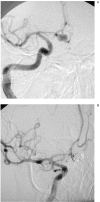Endovascular surgery for ruptured aneurysms with vasospasm
- PMID: 20566076
- PMCID: PMC3345466
- DOI: 10.1177/15910199070130S105
Endovascular surgery for ruptured aneurysms with vasospasm
Abstract
With the existence of vasospasm, it is recommended that direct clipping surgery for a ruptured aneurysm be delayed until its disappearance, but this may be associated with aneurysmal re-rupture resulting in a poor outcome for the patients. Indications for endovascular coil embolization in such cases are discussed. Since November in 2003, we have applied endovascular coil embolization in 11 consecutive patients with ruptured aneurysms and apparent vasospasm of the parent artery from two to 17 days (average: eight days) after initial subarachnoid hemorrhage. Three patients had aneurysmal re-rupture before treatment, but the other eight had only experienced the one episode of subarachnoid hemorrhage. With one exception, all endovascular procedures could be successfully performed, resulting in complete occlusion of aneurysms and remarkable dilatation of inserted spastic vessels without technical complications or aneurysmal re-rupture. For the one case of failure because of a tortuous artery, direct clipping surgery was performed after disappearance of vasospasm. Cerebral infarction occurred in four, but only one correlated with the distribution of catheterization, and neurological deficits had completely disappeared three months after the onset. This preliminary report concerning a small number of patients suggests that endovascular coil embolization is not contra-indicated for aneurysms with vasospasm requiring catheterization. A large study for confirmation is now warranted.
Figures


Similar articles
-
Efficacy of endovascular surgery for ruptured aneurysms with vasospasm of the parent artery.J Neurointerv Surg. 2012 May;4(3):190-5. doi: 10.1136/neurintsurg-2011-010007. Epub 2011 Jun 16. J Neurointerv Surg. 2012. PMID: 21990485
-
Risk of Re-Rupture, Vasospasm, or Re-Stroke after Clipping or Coiling of Ruptured Intracranial Aneurysms: Long-Term Follow-Up with a Propensity Score-Matched, Population-Based Cohort Study.J Pers Med. 2021 Nov 16;11(11):1209. doi: 10.3390/jpm11111209. J Pers Med. 2021. PMID: 34834561 Free PMC article.
-
Neurological outcomes following intraprocedural rerupture during coil embolization of ruptured intracranial aneurysms.J Neurosurg. 2015 Jan;122(1):128-35. doi: 10.3171/2014.9.JNS14616. J Neurosurg. 2015. PMID: 25361491
-
Complex intracranial aneurysms: combined operative and endovascular approaches.Neurosurgery. 1998 Dec;43(6):1304-12; discussion 1312-3. doi: 10.1097/00006123-199812000-00020. Neurosurgery. 1998. PMID: 9848843 Review.
-
Coadjuvant Treatment of Vasospasm in Ruptured Unsecured Cerebral Aneurysms with Aggressive Angioplasty, Intra-Arterial Nimodipine, and Aneurysm Embolization.World Neurosurg. 2018 Aug;116:e452-e459. doi: 10.1016/j.wneu.2018.05.005. Epub 2018 May 16. World Neurosurg. 2018. PMID: 29753899 Review.
Cited by
-
Coiling for Ruptured Aneurysms in the Vasospasm Period: Safety and Efficacy Based on a Propensity Score Analysis.J Neuroendovasc Ther. 2022;16(3):141-146. doi: 10.5797/jnet.oa.2021-0034. Epub 2021 Aug 14. J Neuroendovasc Ther. 2022. PMID: 37502280 Free PMC article.
References
-
- Kassell NF, Torner JC, et al. The international cooperative study on the timing of aneurysm surgery. Part 1: overall management results. J Neurosurg. 1990;73:18–36. - PubMed
-
- Torner JC, Kassell NF, et al. The timing of surgery and vasospasm. Neurosurgery Clinics of North America. 1990;1:335–347. - PubMed
-
- Weir B, Rothberg C, et al. Relative prognostic significance of vasospasm following subarachnoid hemorrhage. Can J Neurol Sci. 1975;2:109–114. - PubMed
-
- Brilstra EH, Rinkel GJE, et al. Rebleeding, secondary ischemia, and timing of operation in patients with subarachnoid hemorrhage. Neurology. 2000;55:1656–1660. - PubMed
-
- Findlay JM. A Canadian Neurosurgical Society practice guidelines review group: Current management of aneurysmal subarachnoid hemorrhage guidelines from the Canadian neurosurgical society. Can J Neurol Sci. 1997;24:161–170. - PubMed
LinkOut - more resources
Full Text Sources

